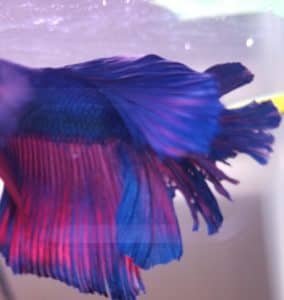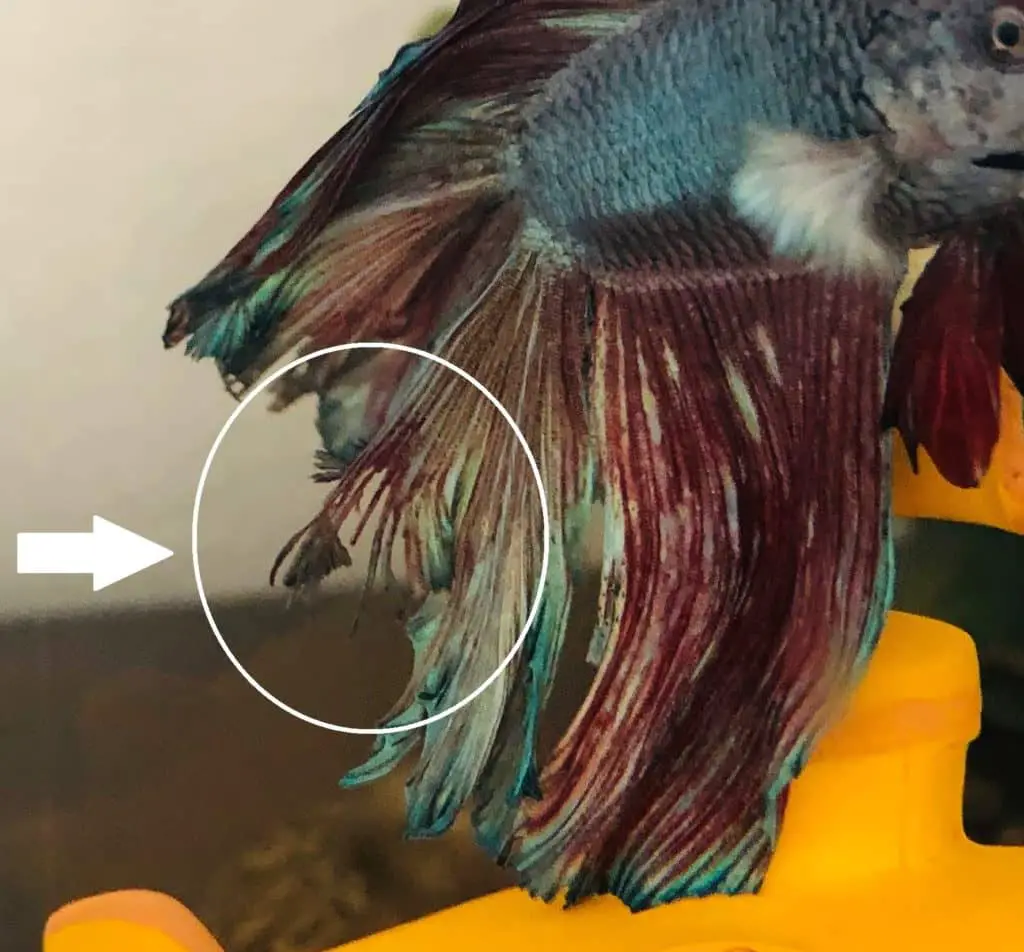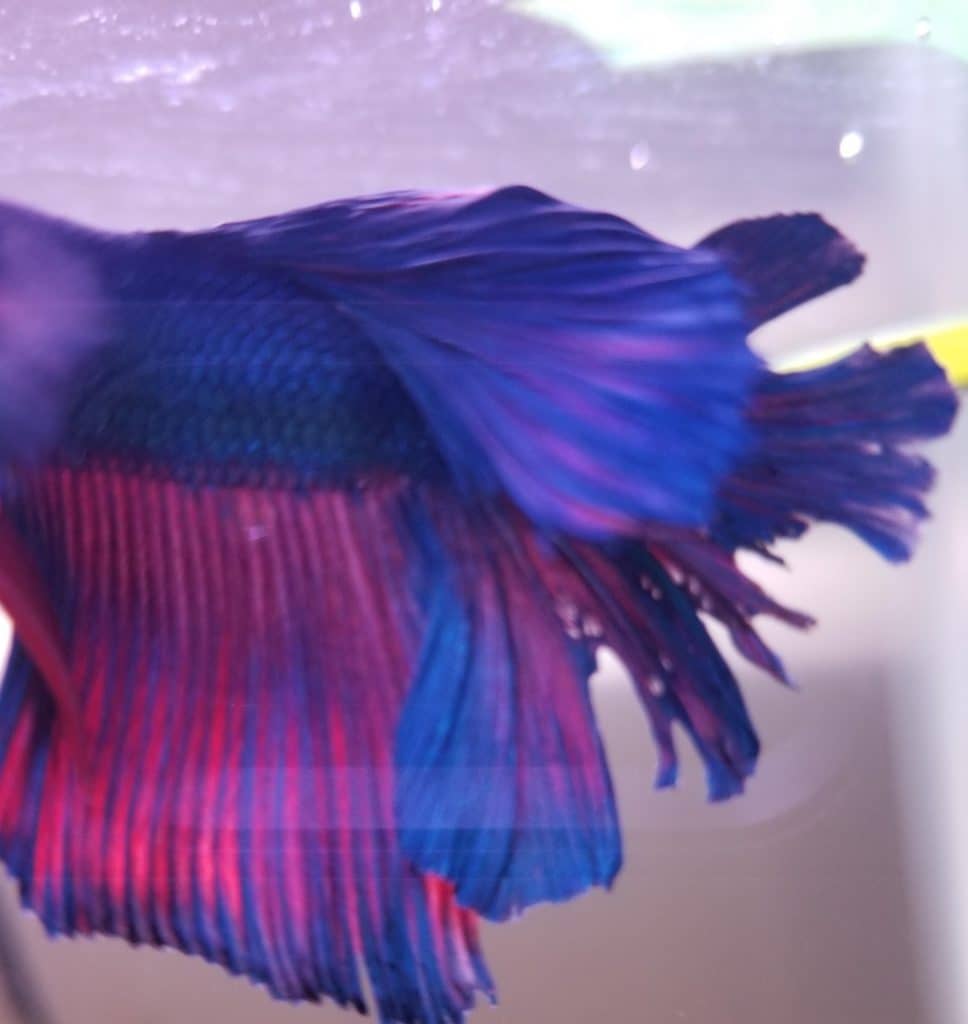Betta is one of the magical and amazing fish in the fish world due to its vibrant and varied colors and diverse morphology. Because of their large and flowing fins, Betta has to face common circumstances such as betta fin loss and fin rot. There are many different reasons to lose betta fish fins and you don’t have to worry about all of them.

However, it is important to know what the various causes can be as well as how to treat and prevent them as an aquarium. Continuing reading will help you find the answers to your questions easily. So let’s see Betta Fin Rot vs Fin Loss
“Want to keep your Betta Fish healthy and happy? Discover everything you need to know about Betta Fish Diseases and how to prevent them by reading our in-depth guide here.” Betta Fish Diseases
How to identify Betta fin rot vs fin loss
Jump To
- 1 How to identify Betta fin rot vs fin loss
- 2 Signs of fin rot
- 3 What does fin rot look like?
- 4 How long does Fin Rot take to heal?
- 5 How do you treat betta fish fin rot naturally?
- 6 How Do You Know If Fin Rot Is Cured?
- 7 Is it a normal thing for betta fish to lose their fins?
- 8 What Causes Betta Fish Fin Loss?
- 9 How do I fix my betta’s fin loss?
- 10 Will betta fish fins grow back?
- 11 What happens if a fish loses a fin?
- 12 Why are my betta fish fins splitting?
- 13 Will Split fins heal?
- 14 Betta fin melt
The difference between fin loss and betta fin rot cannot be always identified obviously, but there is a real difference. However, you can identify the difference based on its cause. Betta Fins loss is the result of physical damage from sharp tank decorations, nipping from other fish, or snagged fins. Fin loss happens when something cleaves the fin tissues.
Betta Fin rot is a result of negative bacterial infection due to poor water conditions. It is probably the number one most common Betta disease and if you own Betta you will be dealing with fin rot. There is a risk to expose Betta to ammonia and nitrite in uncycled tanks.
These cause weakening the Betta’s immune system, stress the Betta, and exposure to bacterial infection. Rapid loss of fin tissue, bloody fin tips, or blackened fin edges are the most common symptoms of fin rot. But if you have dark-colored Bettas, these signs are difficult to spot.


Signs of fin rot
The edges of the fins will discolor in the early stages of fin rot, appearing milky at the fin edges. This change is often so subtle that it goes unnoticed until the fins or tail starts to fray. Small pieces of the fins die and start falling off as the infection spreads, leaving a ragged edge.
What does fin rot look like?
- The edges of its fin turn black/brown.
- Fins fray will appear
- Inflamed fins or rot fin
- In large chunks, betta fin tissue or the entire fin may rot away or fall off in severe fin rot
- white dots on fins
How long does Fin Rot take to heal?
This relies on how bad the issue is, to begin with. There should be an improvement within 4-5 days through the use of Fungus Control & Fin Rot treatment. It is very important to keep water quality pristine in the quarantine tank. Because fish have open wounds, to prevent secondary infection from occurring. a water conditioner is the main factor in fin rot.
How do you treat betta fish fin rot naturally?
In treating fin rot, many antibiotics are successful, but the root cause must be treated in order to ensure that the disease does not return. Treatment should involve a change in water and a close review of conditions in the aquarium.
If food debris remains, vacuum the gravel and take precautions to prevent possible overfeeding which causes betta fin rot. Also, it helps susceptible to fin rot in the feature. To get rid of a little bit of fin rot. To treat mild fin rot, use a combination of Maracyn. In order to help absorb some of the fish waste, the addition of live plants is a plus point
Read more Best Water For Betta Fish | Full Guide
How Do You Know If Fin Rot Is Cured?
It can take several days about 5 days to betta the infection cured, but some strong signs of recovery include:
- The fin rot has not advanced,
- There were no other new symptoms.
- Fin regrowth has started
- The appetite and energy level of your fish are returning
Basically, fin rot symptoms will go away.

Is it a normal thing for betta fish to lose their fins?
Yes, it is normal. Because Betta has beautiful, long, and flowing fins, and also Bettas fins are so delicate. Therefore, it can easily catch the things that you use to decorate your tanks such as driftwood, bogwood, plastic trim, plastic plants, and sharp rocks.
Because of that, it can cause to damage Betta’s fins. Like that, fin loss is the physical damage caused by something in the tank. The good news is that losing fins is not a disease link betta fin rot, it is easy to fix.
Symptoms of fins loss are torn fins or small, pin-sized holes in the fins. Fin loss is caused by,
1. Sharp and rough tank decorations
2. Fin-nipping fish
3.Strong filter intake
4. Tail biting
What Causes Betta Fish Fin Loss?
There are various reasons your Betta suffers from losing fins. Before you start treatment, it is important to know what is behind it.
1. Decorations in the tank
If your tank has particularly sharp or rough decorations such as driftwood, bogwood, plastic decorations, plastic plants, and sharp rocks, they can cause loss of fins. However, one of the common problems with Betta fins and tails is how easily they snag things. If you have a rough, sharp rock in your tank or an area where you can catch his fins, then they will tear to pieces.
2. Fin-nipping fish
Fin-nipping fish is the common culprit. Because keep in mind that do not add this fish to your tank. As Betta has to face this type of aggressive fish and Betta can fall prey to them. Tiger barbs are one of example fin nipping fish. If you have fin-nipping fish in your tank and you see them attack your Betta, you should immediately remove the Betta or fin-nipping fish.
3. Strong filter intake
If filter intake is too strong, it can also cause your Betta fins to pull or be sucked into the intake tube. Make sure you have a filter that fits the size of your tank, then the intake is not too strong, or you can turn down the filter flow level.
4. Tail Biting
Your Betta may also bite his tail. This can happen due to stress, aggression, and laziness and some people think it can be hereditary.
Learn more on Why Betta Fins Shredded Overnight? [SOLVED]
How do I fix my betta’s fin loss?
Recognizing the problem as a fin loss rather than betta fin rot is the first step in solving the problem. Once you are concerned about the culprits, whether it is a plastic plant, a piece of bogwood, or a species of harassing fish, the loss of fins can be stopped and repair is begun itself.
Betta fins usually heal quickly but keep an eye on their fins to make sure there are no new tears, splits, or holes, because fin loss means indirectly you have ignored a problem in the tank. It is also a good idea to watch the fin damage to make sure there is no infection because fin rot cause to complicates the treatment.
However, if you want to speed things up, here are some of the best Betta fish treatments to help you heal your fish faster.
1. Keep the water quality good
2. Feed it well
3. Adding aquarium salt to the tank
4. Adding API stress coat
Will betta fish fins grow back?
betta fish regrowth fin tissue after it is lost due to fin rot or fin loss. As new fin tissue begins to grow, it often clears resembling Saran Wrap and is very thin. New tissue is extremely fragile and prone to damage or loss. The important thing is the fact that if your Betta has initially lost fin tissue due to fin rot caused by water quality, water problems should be resolved and the tank kept clean while the fins heal.
Test your water for ammonia, nitrite, and nitrate and increase your water changes while your betta fish heals its damaged fins. Tissue grows relatively rapidly (similar to nail growth rate).
What happens if a fish loses a fin?
Damage to the fin or fin loss can seem dramatic and painful, but the truth is that most fish heal from tail and fin wounds in the same way you do with a cut. In most cases, the fin damage is not visible. But do not panic.
If you make sure you take care of the tank and do everything you can to heal your Betta, his fins should grow back. However, keep in mind that as the fins grow, it becomes extremely fragile and may be damaged again. But It is a good idea to watch the fin damage to make sure there is no infection because fin rot complicates the treatment.
Why are my betta fish fins splitting?
Fins splitting can be occurred due to physical damage from sharp tank decorations, nipping from other fish, or snagged fins. But Be careful not to confuse betta fin rot with biting, tearing, or splitting.
Decorations in the tank
betta fish long, flowing fins can catch and split on driftwood, bogwood, plastic trim, plastic plants, and sharp rocks. Therefore, sharp or rough decorations of your tank can be caused to splitting betta’s fins.
Other fish
If your fish is housing with tank mates or a community tank, you should check and ensure that none of them hit him. Because there are many kinds of aggressive fish such as Tiger Barbs. Betta fish has to face this type of aggressive fish and Betta can fall prey to them.
If you have fin-nipping fish in your tank and you see them attack your Betta, you should immediately remove the betta fish or fin-nipping fish.
Tail Biting
Your Betta may also bite his tail. This can happen due to stress, aggression, laziness and some people think it can be hereditary.
Filter Intake
If the filter intake is too strong, it can also cause your beta fins to pull or be sucked into the intake tube. Make sure you have a filter that fits the size of your tank, then the intake is not too strong, or you can turn down the filter flow level.
Will Split fins heal?
Yes, fishtails and fins heal after being damaged in any way. Betta fish have the ability to heal wounds, make new cells and make tissues. Although this process is not fast, it does help the betta fish to regain the lost body part. Fish have an immune system that helps heal wounds and heal damaged fins and tails. First, the wound begins to heal. New cells then form and the tissue grows once the wound has healed properly.
Firstly, the fins seem to be transparent. After some time, it develops patterns and colors too. The important thing is the fact that if your betta fish has initially lost fin tissue due to betta fin rot caused by water quality, water problems should be resolved and the tank kept clean while the fins heal.
The new fins or tail appear slightly different in color and design than the original. In terms of its functionality, it’s as good as new.
Betta fin melt
As a fish lover, your Betta is a major part of your life. But enemy like fin melt or fin rot cause to fatal of your Betta. Therefore, you can protect your Betta by going through this article.
What is Betta fin melt ?
Fin melt is named fin rot or tail rot. The fin melt is can be defined as rotting or fraying the fins of fish. Fin melt, fin rot, or tail rot is most prevalent in fish with long-flowing fins like Betta fish. The main cause of this disease is an infection of gram-negative bacteria of Aeromonas, Pseudomonas, or Vibrio bacteria. In fin rot disease, the edges of fins are discolored and milky. Often this difference is so subtle that it is not felt until the fins or tail begin to fray.
If you do not recognize it, this fraying of fins happens continuously. The affected area looks red and inflamed, with bloody patches. It is possible to develop secondary fungal infections. Poor water quality, improperly-low water temperature, overcrowding, feeding outdated food, overfeeding, and stress may lead to fin rot or fin melt.
What is fin melt vs fin rot?
Fin rot or fin melt describe the same disease. Fin rot is an infection of gram-negative bacteria or fungi. In the early stage of fin rot, the edges of the fins become discolored and milky at the edge. Often this difference is so subtle that it is not felt until the fins begin to fray.
When the infection spreads, small pieces of fins die and begin to shorten. Fin rot or fin melt is occurred due to poor water quality, improperly-low water temperature, overcrowding, feeding outdated food stress.
What causes Betta fins to shred?
Betta has long, flowing fins. Unfortunately, these fins can be shredded because of various incidents such as:
Fighting
Male Bettas are aggressive. Therefore, they tend to fight with other male Bettas. These fights cause them to shred the Betta’s fins. Because of that two male Bettas were never put in the one fish tank.
Fin nippers
Betta fish bother other fish very rarely. But there are many fin nippers such as Tiger barbs, Black widow tetras, and freshwater puffers, this kind of fish can lead to shred Bettas’ fins.
Shipping and Handling
Bettas tend to damage fins themselves due to various circumstances. As an example, during shipping, Bettas bite their fins. Decorations with sharp edges and sharp corners of ornaments in the aquarium also cause them to shred their fins.
Can Betta fish fins heal?
Yes, Betta fish fins heal or regrow their fin tissues. When beginning the regrowth of fin tissues, it is often the same as Saran Wrap and is very thin. Regrowth fins are mostly the same as the original. But most likely it will look a different shade than the original color.
These new tissues are highly fragile and may have the risk of damage or loss. Tissues grow relatively fast and are similar to the human nail growth rate.
How to treat fin melt in Bettas?
when you start the treatments, you should consider the severity and progression of the rot, also it depends on the ecosystem and the size of ecosystems. After you examine the above matters you can choose the appropriate treatment method.
Betta Mild Fin Rot Treatment
- Make sure the tank water meets the optimum pH level and temperature. The ideal pH level is 6.5-7.5 and the temperature is 78-81F. Change the 50% water with fresh tap water. Make sure the water is free of chlorine, ammonia, or nitrite and that nitrate is less than 40 ppm (mg/L).
- Remove the feces, excess foods, and other debris by using a gravel vacuum. Wash all tank decorations in hot water without using soap. If your tank is overloaded, shift the fish into another tank.
- Monitor your water parameters continuously over the next week. Check if the fin is healing. it takes a lot of time. Also, don’t forget to change 25% water continuously while checking the parameters.
Moderate Fin Rot Treatment
- If your Betta has signs of moderate fin rot or mild rot, you must put him in another tank with conditioned and heated water.
- Clean your filter and replace new filter media with old. change the 100% water and clean everything including the gravel, plants, deco, and the heater with hot water.
- If do not have live plants in your quarantine or hospital tank, add fully dissolve 1-2 teaspoons of aquarium salt into fresh conditioned water before putting your fish. Do not use undissolved salt.
- Change the equal portion of water in the tank before a new dose. Because overdosing causes you to kill your fish. 25%-50% change is the best.
Severe Fin Rot Treatment
if your Betta faces severe fin rot, it requires stronger medication to reverse the damage.
- You should move your fish into a quarantine or hospital tank and should keep the water oxygenated by using an air stone or bubbler.
- Clean the tank and everything in the tank and fill the tank with conditioned water. make sure the parameters are normal in the water.
- Give the recommended medicated dose to your fish. You should choose a take based on whether the rot is fungal or bacterial. You must follow the instructions properly.
- Remember that you must make 100% water changes before re-dosing.
Can fin melt kill my Betta?
Fin rot or fin melt is a common disease. But if you do not treat your fish Better, fin melt or fin rot can kill your Betta. You should take action immediately when you recognize the fin rot. In extreme cases, fin melt or fin rot can reduce your Betta’s life expectancy by up to a few weeks.
How to reverse fin melt in Betta
You should do treatments to reverse the fin rot or fin melt such as changing water, avoiding overfeeding, maintaining parameters of water (pH and temperature), and administering recommended medications by treating well you can heal the fins of your Betta. And you can protect the life of your Betta.
Read Next: Hospital Tank For Betta | Correct Setups |
Read Next: Understanding Betta Dropsy: Causes, Symptoms, and Treatment
